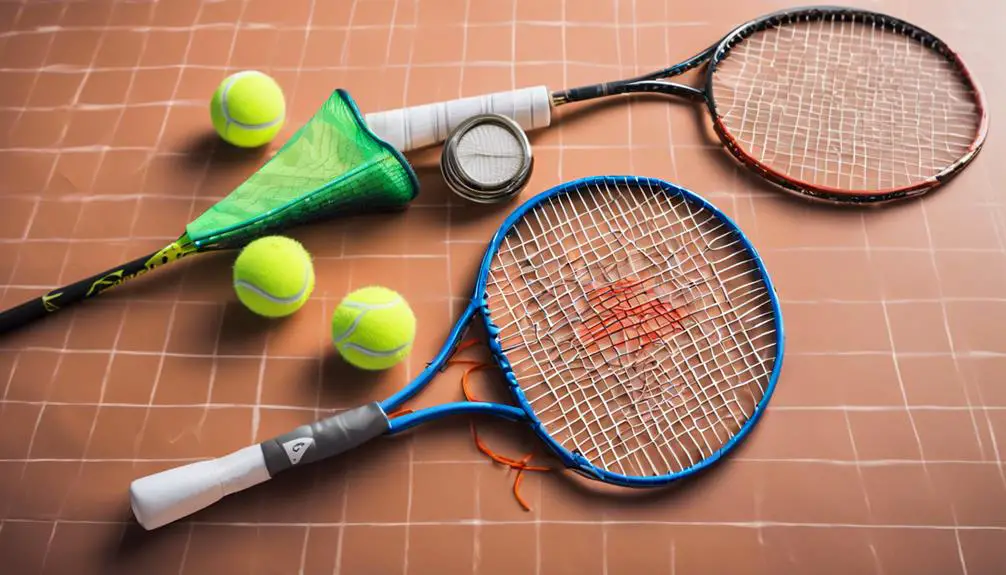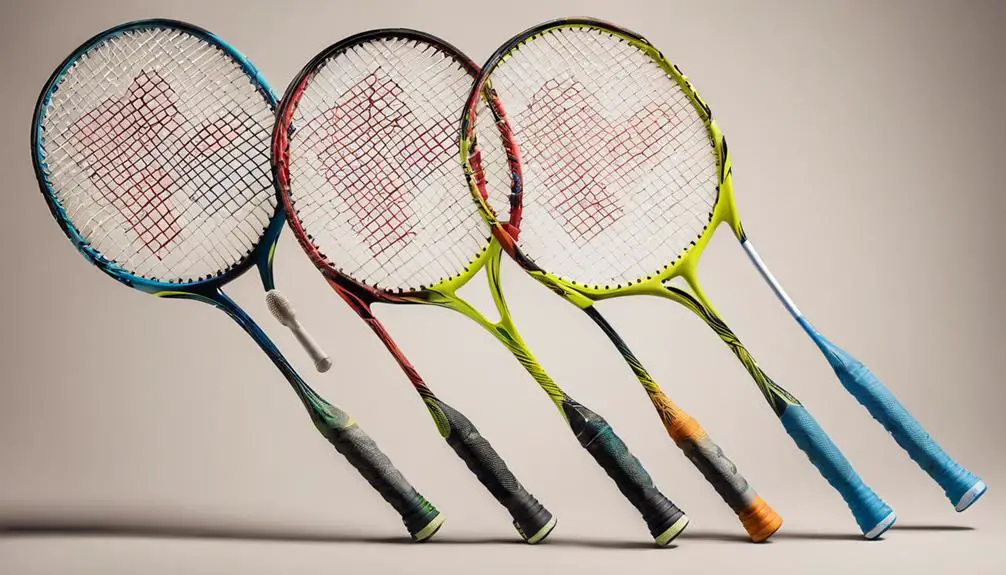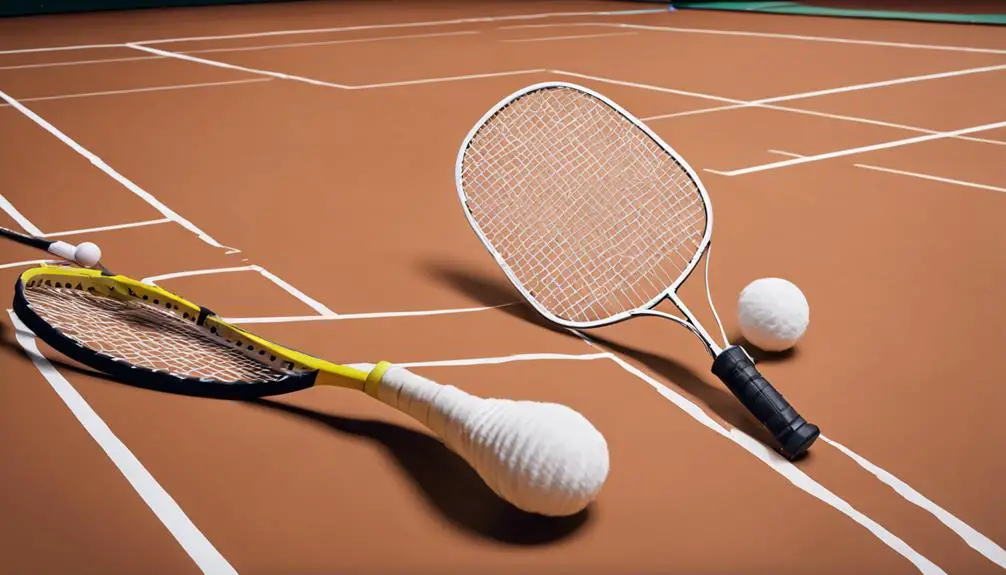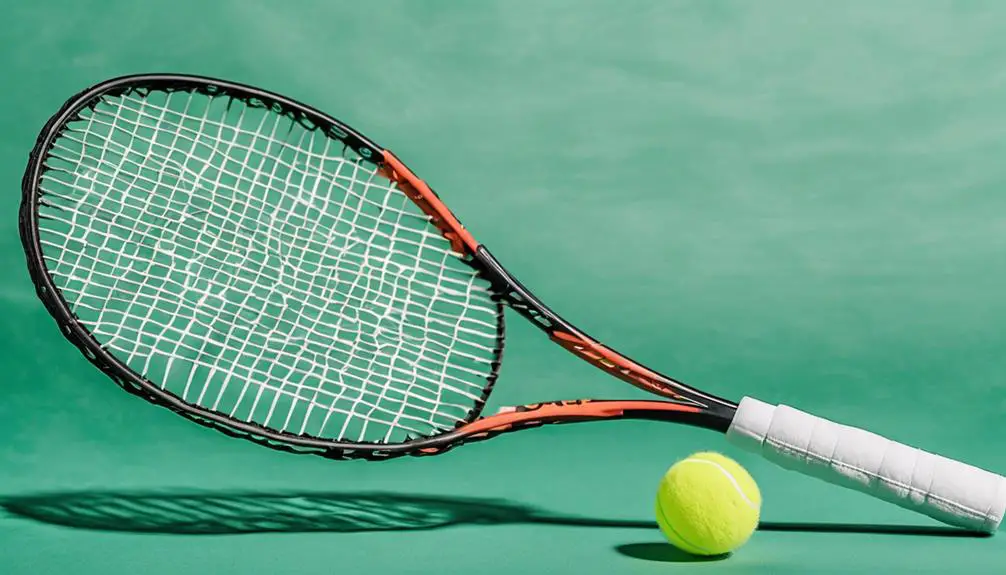When you’re comparing badminton and tennis rackets, you’ll notice key differences in design and weight. Badminton rackets are lightweight, enhancing your agility for quick exchanges. They also feature a thinner frame, allowing for precise control. In contrast, tennis rackets are heavier and sturdier, providing the power needed for strong serves and groundstrokes. Material choice impacts performance, with options like graphite and aluminum being popular. Grip styles also vary, influencing comfort and shot precision. Understanding these differences will help you choose the right racket for your game. There’s much more to explore about optimizing your play style!
Overview of Racket Sports

Racket sports, with their dynamic gameplay and strategic depth, offer a unique blend of physical exertion and mental agility. From the fast-paced exchanges of badminton to the powerful serves in tennis, these sports have evolved considerably throughout history, showcasing a fascinating timeline of development. Each sport’s history reveals how player techniques have adapted over time, influenced by changes in equipment, playing surfaces, and training methods.
As you immerse yourself in the world of racket sports, you’ll notice how the evolution of these games affects player techniques. For instance, in badminton, players have honed their agility and reflexes to respond to rapid shuttlecock movements. Techniques like the jump smash and deceptive dropshot highlight the sport’s emphasis on quick decision-making and precision. Meanwhile, in tennis, the evolution of strokes—such as the topspin forehand—has transformed the way the game is played, pushing players to master a variety of techniques for successful rallies.
Understanding the history of these sports not only enriches your appreciation but also enhances your gameplay. By grasping how techniques have evolved, you can experiment with different styles to find what suits you best. Whether you’re looking to dominate on the court or simply enjoy a friendly match, knowing the nuances of each sport can empower your performance and strategy. Ultimately, racket sports are more than just games; they’re a reflection of continuous growth and innovation, offering endless opportunities for personal expression and mastery.
Design Differences
The differences in racket design between badminton and tennis play a significant role in shaping the gameplay and overall experience of each sport. When you look at a badminton racket, you’ll notice it’s lightweight with a longer, thinner frame, designed to enhance its aerodynamic features. This design allows for quick swings and rapid reactions, vital for the fast-paced nature of badminton. The wide string bed and smaller head size facilitate precise shots, giving you greater control over the shuttlecock.
On the other hand, a tennis racket features a much sturdier frame and a larger head. The aerodynamic features in tennis rackets focus on generating power and stability, which is essential for hitting the heavier tennis ball. This sturdiness allows players to execute powerful serves and groundstrokes while maintaining control.
When it comes to handle shapes, badminton rackets typically have slimmer, more elongated grips to accommodate quick wrist movements. You’ll find that this design helps in executing intricate shots with finesse. In contrast, tennis rackets often have thicker handles, which provide a more stable grip for powerful swings. This difference in handle shapes reflects the contrasting styles of play in each sport.
Ultimately, the design differences in badminton and tennis rackets are tailored to optimize performance for each game’s unique demands, highlighting how equipment can influence your experience on the court. Understanding these nuances can enhance your appreciation for both sports and help you choose the right racket if you decide to explore one of them.
Weight Comparison

When comparing the weight of badminton and tennis rackets, you’ll find striking differences that greatly influence gameplay. Badminton rackets typically weigh between 70 to 100 grams, while tennis rackets usually range from 260 to 320 grams. This weight disparity is essential to reflect on if you want to optimize your performance in either sport.
A lighter badminton racket allows for quicker reflexes and faster swings, important for the game’s fast-paced nature. You’ll appreciate how a lighter frame helps with maneuverability, enabling you to react swiftly to your opponent’s shots. The balance of the racket plays a key role here; a head-light racket provides more control, while a head-heavy option can deliver more power. Your player preferences will dictate which balance feels most comfortable and effective during play.
On the other hand, the heftier tennis racket offers stability and power, especially on groundstrokes and serves. The additional weight helps absorb the impact of the ball, allowing for a more controlled shot. However, this might not suit everyone; some players may prefer a lighter racket for enhanced agility at the net.
Ultimately, whether you lean towards badminton or tennis, understanding the fundamental differences in weight can help you find the right racket that aligns with your style and preferences. Choosing wisely can greatly enhance your game, giving you that much-desired freedom to express your skills on the court.
String Tension Explained
String tension serves as a critical determinant of performance in both badminton and tennis, influencing everything from power to control. Understanding how string tension affects your game can lead to more tailored performance, giving you that edge you crave.
When you think about string tension, consider the following effects:
- Power: Higher tension offers more control but may require more force to generate power.
- Control: Tighter strings improve accuracy, allowing for precision shots.
- Spin: Different techniques can manipulate tension to enhance spin potential.
- Comfort: Lower tension can reduce shock and increase comfort during play.
- Durability: Higher tension may lead to quicker string wear, affecting your racket’s longevity.
Using various string tension techniques, you can optimize your racket setup. For instance, if you often find yourself over-hitting, you might want to increase the tension to gain better control. On the other hand, if you’re struggling with power, reducing the tension could provide that extra boost you need.
Ultimately, the right tension is subjective and varies based on personal playing style and preferences. Experimenting with different tensions will help you discover what feels best for your game. By honing in on string tension effects, you’re not just changing your racket; you’re evolving your entire approach to badminton or tennis. Embrace the freedom to explore these adjustments and find your perfect setup.
Grip Styles

Finding the right grip style can greatly impact your performance in badminton and tennis, complementing the adjustments you make with string tension. Grip types play an important role in how effectively you can handle your racket, affecting your control, power, and overall comfort during play.
In badminton, you’ll often use a basic grip, such as the forehand or backhand grip, depending on your shot. The forehand grip allows for greater wrist flexibility and quicker responses, while the backhand grip offers stability for defensive shots. On the other hand, tennis players benefit from a variety of grip types, including the Eastern, Western, and Continental grips. Each grip serves different shot styles, allowing for spin and power, which can transform your game.
Grip size is another significant factor to take into account. A grip that’s too small can lead to excessive wrist movement, potentially causing injuries. Conversely, a grip that’s too large may reduce your control and increase fatigue. You should measure your hand size to confirm you choose the right grip size, which directly influences your comfort and performance.
Ultimately, experimenting with different grip types and sizes is essential. It’s about finding what feels right for you, enhancing your freedom of movement, and enabling you to express your style on the court. Remember, the perfect grip can be the difference between a good shot and a great one.
Material Variations
In the world of racket sports, the choice of materials used in badminton and tennis rackets can greatly influence performance and playability. The materials not only affect how a racket feels in your hand but also its durability factors and overall responsiveness on the court. Understanding these variations can help you make an informed choice tailored to your playing style.
Badminton rackets typically prioritize lightweight performance materials, allowing for quick maneuvers and swift shots. On the other hand, tennis rackets often incorporate heavier materials to provide stability and power during strokes. Here’s a closer look at some key material variations:
- Graphite: Common in both sports, it offers a great balance of strength and weight.
- Aluminum: Generally found in entry-level models; it’s affordable but heavier, impacting maneuverability.
- Carbon Fiber: High-end option for serious players, known for its exceptional strength-to-weight ratio.
- Wood: Traditional material, mainly seen in vintage rackets, providing unique feedback but lacking modern performance.
- Composite Materials: A blend of materials that enhance both performance and durability factors.
As you explore your options, consider how these materials align with your personal preferences and playing goals. The right racket can enhance your game, offering the freedom to express your style while maintaining durability and performance. Whether you’re smashing a shuttlecock or serving a tennis ball, knowing the material variations can elevate your experience on the court.
Impact on Gameplay

The choice of materials in rackets has a direct correlation to how players experience the game, influencing everything from shot accuracy to overall control. When you pick up a racket, you’re not just holding a piece of equipment; you’re wielding a tool that can enhance or hinder your stroke technique and game strategy.
In badminton, lightweight rackets allow for quick reflexes and rapid changes in direction, which is essential for effective net play and smashes. Conversely, tennis rackets, often heavier and sturdier, enable players to generate power while maintaining control over their strokes. This distinction affects how you approach each game, as the materials dictate your ability to execute precise shots.
Here’s a breakdown of how the material impacts gameplay for both sports:
| Aspect | Badminton Racket | Tennis Racket |
|---|---|---|
| Weight | Lightweight for agility | Heavier for power |
| Flexibility | More flexible for quick shots | Stiffer for consistent strokes |
| Control | High control for delicate net play | Moderate control for powerful serves |
| Shot Speed | Quick, fast-paced exchanges | Slower, more strategic rallies |
| Stroke Technique Impact | Encourages finesse and agility | Promotes power and depth in strokes |
Understanding these differences helps you adapt your game strategy. Whether you’re smashing a shuttlecock or serving a tennis ball, the right racket can transform your performance and elevate your gameplay.
Choosing the Right Racket
Selecting the right racket can be a game-changer, greatly impacting your performance and enjoyment in either badminton or tennis. With so many options available, it’s vital to take into account your player skill levels and preferences. Here are some racket selection tips to help you make the best choice:
- Weight: Lighter rackets offer better maneuverability, while heavier ones provide more power.
- Grip Size: A proper grip size guarantees comfort and control during play; too small or too large can lead to injuries or poor handling.
- String Tension: Higher tension yields more control, while lower tension gives you a softer feel and added power.
- Material: Graphite rackets are popular for their strength and lightness, whereas aluminum options can be more durable for beginners.
- Head Size: Larger head sizes provide a bigger sweet spot, making it easier to hit the ball.
Popularity and Accessibility

Badminton and tennis each boast a unique charm that contributes to their popularity and accessibility around the world. Both sports have a dedicated fan base, but their paths to engagement differ greatly. Tennis often attracts a more mainstream audience, thanks to high-profile tournaments like Wimbledon and the US Open. These events not only showcase elite skill levels but also inspire recreational play, allowing players of various abilities to envision themselves on the court.
In contrast, badminton shines in accessibility. It’s a sport that can be played in smaller spaces, making it ideal for urban environments where courts may be scarce. You don’t need a large area or fancy facilities to enjoy a game. A simple net and a few friends can turn any backyard or gym into a badminton court. This ease of access allows for greater participation among diverse groups, from casual players to those seeking competitive tournament participation.
When considering skill levels, both sports accommodate everyone from beginners to seasoned athletes. However, badminton’s fast-paced nature often encourages more immediate engagement, allowing players to pick up the basics quickly. This can lead to a more inviting atmosphere for newcomers, fostering a sense of community.
Ultimately, whether you’re drawn to the grandeur of tennis or the approachable spirit of badminton, both sports offer pathways for enjoyment and competition that cater to individual preferences and environments. Your choice might just depend on what you’re looking for in a sport—whether it’s social interaction, competition, or simply a fun way to stay active.
Frequently Asked Questions
Can I Use a Tennis Racket for Badminton?
You can use a tennis racket for badminton, but its weight and string tension won’t be ideal. The heavier racket may hinder your agility, and the string tension isn’t suited for the shuttlecock’s dynamics.
What Is the Average Lifespan of Each Racket Type?
Ever wondered how long your racket might last? Generally, a well-maintained racket can last 3-5 years, depending on the materials used. Regular maintenance tips, like proper storage, can extend its life even further.
Are There Specific Brands Known for Badminton or Tennis Rackets?
When considering brand comparisons, you’ll find specific brands emphasizing performance features tailored to your game. Exploring options like Yonex for badminton or Wilson for tennis can enhance your experience, offering innovative designs aimed at maximizing play.
How Do Weather Conditions Affect Racket Performance?
Did you know that temperature can alter string tension by up to 10%? Weather conditions impact racket performance considerably, as material composition affects flexibility and resilience, ultimately influencing your game’s accuracy and power.
Can I Customize My Racket’s Grip Size Easily?
Yes, you can customize your racket’s grip size easily. Just use grip tape to adjust thickness and add grip cushioning for comfort. This way, you’ll enhance your control and feel, tailoring the racket to your preferences.




